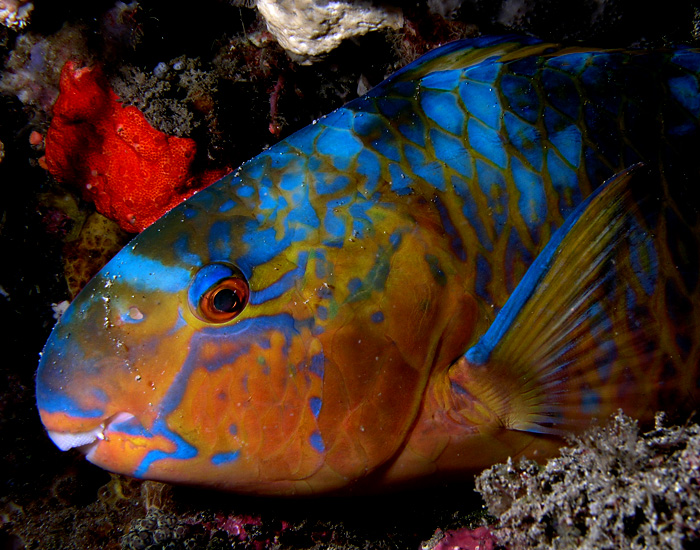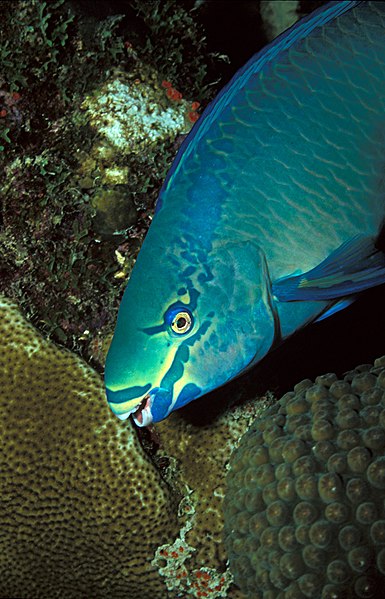 Hello, Frank Indiviglio here. Marine aquarists and divers are well-aware of the mucous “sleeping bags” produced by Parrotfishes and certain Wrasses each night. It was assumed that these cocoon-like structures discouraged eels, crabs and other nocturnal predators – perhaps the mucous hid the sleeper’s scent, or was bad-tasting or toxic. A study at Australia’s Queensland University, however, has revealed that the mucous cocoon’s main purpose may be to deter external blood-sucking parasites – the first known example of such a phenomenon.
Hello, Frank Indiviglio here. Marine aquarists and divers are well-aware of the mucous “sleeping bags” produced by Parrotfishes and certain Wrasses each night. It was assumed that these cocoon-like structures discouraged eels, crabs and other nocturnal predators – perhaps the mucous hid the sleeper’s scent, or was bad-tasting or toxic. A study at Australia’s Queensland University, however, has revealed that the mucous cocoon’s main purpose may be to deter external blood-sucking parasites – the first known example of such a phenomenon.
A Good Reason to Hide
Writing in the November 17, 2010 issue of the journal Royal Society Biology Letters, researchers have established that sleeping Parrotfishes suffer numerous parasite attacks when deprived of their mucous cocoons (I couldn’t determine how they removed the cocoons without waking the fish!). Parrotfishes with intact cocoons sleep peacefully through the night, and were rarely bitten.
 The parasites involved are common marine organisms known as Gnathiid Isopods, and are related to the familiar terrestrial Sow or Potato Bugs. As you can see from the accompanying photo, they have very impressive mouthparts – I’d cover-up if they were after my blood (actually, I have slept under nets when doing research in Vampire Bat territory – it was uncomfortable but well-worthwhile!).
The parasites involved are common marine organisms known as Gnathiid Isopods, and are related to the familiar terrestrial Sow or Potato Bugs. As you can see from the accompanying photo, they have very impressive mouthparts – I’d cover-up if they were after my blood (actually, I have slept under nets when doing research in Vampire Bat territory – it was uncomfortable but well-worthwhile!).
Gnathiid Isopods drive quite a bit of marine fish behavior – Cleaner Wrasses and Cleaner Shrimp remove them from many fish species by day.
Creating a Cocoon
Parrotfishes manufacture the copious amounts of mucous needed for their cocoons with the aid of glands located beneath the gill covers and behind the gills. The mucous is secreted from the mouth and slides back over the fish, eventually covering it completely.
The cocoon has been described as “Jell-O-like” in texture, and is largely invisible until it acquires a coating of current-driven sand or mud (please check out the accompanying photo of a sleeping parrotfish – you can see bits of sand attached to its otherwise invisible mucous cocoon).
Future Research
 It is not known whether the mucus physically prevents parasites from reaching the fish (which seems likely) or if a chemical deterrent is involved. By disguising the owner’s scent, the cocoon may also render it difficult for Isopods to locate potential victims.
It is not known whether the mucus physically prevents parasites from reaching the fish (which seems likely) or if a chemical deterrent is involved. By disguising the owner’s scent, the cocoon may also render it difficult for Isopods to locate potential victims.
Also open to question is the cocoon’s role (if any) in preventing attacks by fishes, crabs and other predators.
Further Reading
A photo of a Parrotfish’s cocoon and further info can be found here.
Queen Parrotfish video.
Please write in with your questions and comments.
Thanks, until next time,
Frank Indiviglio
Timor Parrotfish image referenced from wikipedia and originally posted by Nhobgood
Gnathiid Isopod image referenced from wikipedia and originally posted by Y-zo
Princess Parrotfish image referenced from wikipedia and originally posted by LASZLO ILYES
 That Fish Blog – Aquarium Advice and Information
That Fish Blog – Aquarium Advice and Information


One comment
Pingback: Fish News – Mucous Covering Protects Sleeping Parrotfishes from Parasites | Fish Mart